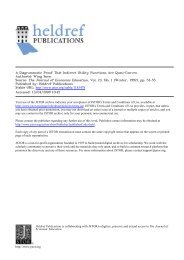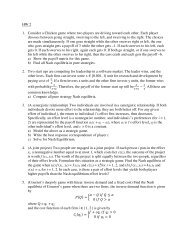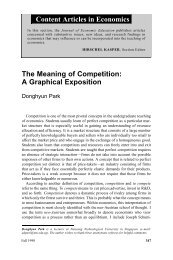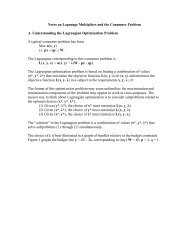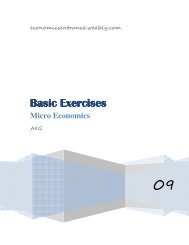Download File - Weebly
Download File - Weebly
Download File - Weebly
You also want an ePaper? Increase the reach of your titles
YUMPU automatically turns print PDFs into web optimized ePapers that Google loves.
2010<br />
DSE-Entrance<br />
Solutions<br />
Economics<br />
This document contains solutions of past year exam problems asked in Delhi<br />
School of Economics entrance exams held for admissions to their masters<br />
program(2004-08).<br />
Disclaimer: The solutions offered in the document can be incorrect, the likelihood<br />
of which is very small though, so use at your own risk. The possible reasons for<br />
mistakes could be my ignorance or laziness with former being more likely of the<br />
two.<br />
Amit Kumar Goyal<br />
economicsentrance.weebly.com, beaneconomist.com<br />
2/15/2010
Entrance Exam solutions economicsentrance.weebly.com beaneconomist.com<br />
Prepared by: Amit Kumar Goyal<br />
DSE: Year 2004<br />
Part - 1<br />
1. (b) only proposition (i) is true<br />
2. (b) there exists a solar system in the milky way galaxy such that every<br />
planet in it has a moon revolving around it without any life forms<br />
3. (c) x1=y1, for x1Є[0,1000]<br />
4. (c) x1=y1, for x1Є[0,1000]<br />
5. (d) both α and β are pareto efficient<br />
6. (b) x1=999 and y1Є[999,1000]<br />
7. (a) (1,0)<br />
8. (c) s1 = (3-4c)/(3-2c) and s2 = 2c/(3-2c)<br />
9. (b) no<br />
10. (a) ½<br />
11. (d) produce nothing in Plant 1<br />
12. (c) ¼<br />
13. (a) (-5/2, 0)<br />
14. (d) √200 – 10<br />
15. (b) ((10-√200)/4, (10-√200)/6)<br />
16. (a) deficit decreases by 15-√200<br />
17. (d) removing the water subsidy and providing a lump-sum subsidy.<br />
18. (b) (µβ+α)/P[µ(1-c)+αλ]<br />
19. µ/[µ(1-c)+αλ]<br />
20. (d) Y = f(½)<br />
21. (b) max {W0, P/2}<br />
22. (a) min{½, 1- W0/P}<br />
23. (c) f(½)<br />
24. (c) Y does not decrease and P increases<br />
25. (b) Y does not increase and P decreases<br />
26. (c) 2/3<br />
[2]
Entrance Exam solutions economicsentrance.weebly.com beaneconomist.com<br />
27. (d) 3/32<br />
28. (a) 2/3<br />
29. (c) 7.4<br />
30. 2p 2<br />
Part – 2<br />
1. (A) Effect of a marginal increase in G on AD:<br />
Y = C(Y-T) + I(r) + G, M/P=L(Y, r)<br />
Differentiating totally,<br />
(1-CY)dY - Irdr = dG<br />
LYdY + Lrdr = dM/P<br />
Solving,<br />
dY/dG = Lr/(Lr(1-CY)+ IrLY)<br />
Refer book for explanation<br />
(B) Refer book for explanantion<br />
2. (A) (a) np(1-p)(p n-2 +(1-p) n-2 )<br />
(b) (1- np(1-p)(p n-2 +(1-p) n-2 )) k-1 (np(1-p)(p n-2 +(1-p) n-2 ))<br />
(B) (a) a=1/48<br />
(b) 7/24<br />
(c) 3/4<br />
3. (A) f(x1, x2)= x2g(x1/x2) ( BY CRS )<br />
MP1= g’(x1/x2)<br />
MP2= g(x1/x2)-(x1/x2) g’(x1/x2)<br />
MP11= (1/x2)g”(x1/x2) < 0, (given in (b))<br />
Hence, MP12=- (x1/(x2) 2 )g”(x1/x2) > 0 Similarly, MP21 > 0.<br />
(B) For a33 ‡ 3<br />
Economic interpretation : For a33 ‡ 3, the three securities when<br />
combined appropriately can generate any return.<br />
(C) To show : f is convex if and only if {(x,r)|f(x)≤r} is convex.<br />
Suppose f is convex.<br />
[3]
Entrance Exam solutions economicsentrance.weebly.com beaneconomist.com<br />
To show: {(x,r)|f(x)≤r} is convex<br />
Let (x1,r1), (x2,r2) belongs to {(x,r)|f(x)≤r} . So, f(x1)≤r1 and f(x2)≤r2<br />
Take 0
Entrance Exam solutions economicsentrance.weebly.com beaneconomist.com<br />
Prepared by: Amit Kumar Goyal<br />
DSE: Year 2005<br />
Part - 1<br />
1. (d) (x1,y1)=(100,100) and (x2,y2)=(50,0)<br />
2. (a) (x1,y1)=(50,50) and (x2,y2)=(100,50)<br />
3. (c) (1/3, 2/3)<br />
4. (b) (x1,y1)=(50,50) and (x2,y2)=(100,50)<br />
5. (b) a Tribe<br />
6. (d) a Tribe<br />
7. (b) There are at least two sets of individuals that are both a Club and a<br />
Tribe.<br />
8. (a) a Club<br />
9. (a) q1=a/3b and q2=(a-3)/3b<br />
10. (b) The market share of the more efficient firm decreases.<br />
11. (c) q1 will increase and q2 will decrease.<br />
12. (d) produce nothing in plant 2.<br />
13. (d) Every book by Bourbaki contains a chapter such that the validity of<br />
all the theorems in it is independent of the reader’s gender.<br />
14. (c) 11.2<br />
15. (c) 1/3<br />
16. (a) 5/8<br />
17. (b) 2/9<br />
18. (b) 1/2<br />
19. (c) 2p 2<br />
20. (a) 2/3<br />
21. (b) n-n(mean(y))<br />
22. (c) 48/65<br />
23. (c) 3<br />
24. (c) right if the price level falls and/or the quantity of money rises.<br />
25. (d) None of the above choices is correct<br />
[5]
Entrance Exam solutions economicsentrance.weebly.com beaneconomist.com<br />
26. (b) one; zero<br />
27. (a) IS curve was vertical and stuck at a low level of income.<br />
28. (c) ½; -½<br />
29. (b) decreasing; decreasing<br />
30. (a) increasing; increasing<br />
Part – 2<br />
1. (A)(a) Required Variance=25/49+36/49=61/49<br />
(b) Required Variance = 50<br />
(c) Null Hypothesis: H0 = µA-µB=0<br />
Test statistic value: z = (mean(xA)-mean(xB))/√[(25/36)+(36/49)] =<br />
-25/1.2 ≈ -20, Null is rejected.<br />
(B) (a) True<br />
(b) True<br />
(c) False<br />
(d) False<br />
(e) True<br />
2. Given the information we can derive that Aggregate supply curve will be<br />
vertical, hence an increase in supply of money will shift AD curve<br />
outwards and can only lead to rise in prices without affecting the output.<br />
3. (A) (a) SC =pxx+(25py)/x.<br />
(b) LC =10(pxpy) 1/2<br />
(c) x = 5(py/px) 1/2<br />
(d) x = (3.5) (2py/px) 1/2<br />
(B) (q1,q2,q3)=(1/2,1/4,1/8)<br />
4. (A) Refer Textbook<br />
(B) (a) a33 ‡ -3; (b) Price = 61/6<br />
[6]
Entrance Exam solutions economicsentrance.weebly.com beaneconomist.com<br />
Prepared by: Amit Kumar Goyal<br />
DSE: Year 2006<br />
Part - 1<br />
1. (b) pareto efficient<br />
2. (d) all of the above<br />
3. (b) a private good<br />
4. (b) monopsony<br />
5. (d) C = Q√(wr)<br />
6. (d) complete crowding out and no increase in equilibrium income<br />
7. (b) the IS curve is vertical and the LM curve is upward sloping.<br />
8. (b) 115.3<br />
9. (d) 3/8<br />
10. (d) A consumer’s budget share for an inferior good decreases with an<br />
increase in money income.<br />
11. (b) Income elasticity of good x is 0.<br />
12. (c) 1/3<br />
13. (c) remains constant<br />
14. (d) any of the above three conditions is satisfied<br />
15. (c) f is quasi-convex<br />
16. (a) does not change the value of the determinant of A<br />
17. 1/25<br />
18. (d) 0.82<br />
19. (c) under flexible exchange rates when the exchange rate rises<br />
(depreciates) above and then falls down to equilibrium after a monetary<br />
expansion<br />
20. (c) fiscal policy is an effective tool for stabilizing the economy<br />
Part - 2<br />
21. (b) not a competitive equilibrium allocation but is pareto efficient<br />
22. (a) a competitive equilibrium allocation and is pareto efficient<br />
[7]
Entrance Exam solutions economicsentrance.weebly.com beaneconomist.com<br />
23. (b) (0,1)<br />
24. (c) 50 units<br />
25. (a) equilibrium output increases by 160/3 units<br />
26. (b) Current Employment: 400; Employment tomorrow: 424<br />
27. (c) Rs. 4000<br />
28. (b) 0.56<br />
29. (b) q1=2 and q2=2<br />
30. (b) A has x=2, y=0 and B has x=0, y=2<br />
31. (a) 5/14<br />
32. (d) 2/7<br />
33. (b) 0<br />
34. (b) 128<br />
35. (b) has a greater impact on income than in a closed economy<br />
36. (d) an increase in the interest sensitivity of money demand<br />
37. (c) The line defined by y = x + 2 and the vertical axis.<br />
38. (a) the smaller the induced change in interest rates and smaller the<br />
responsiveness of investment to these changes<br />
39. (d) the level of profits<br />
40. (b) (x1, x2) = (2/18, 5/18)<br />
41. (c) x1 increases and x2 decreases<br />
42. (c) (15, 7)<br />
43. (b) Y = 12500 – 50r<br />
44. (d) does not change, ever increasing<br />
45. (c) leaves unchanged<br />
46. (d) 7/15<br />
47. (b) 121/256<br />
48. (c) 4/13<br />
49. (a) 28/30<br />
50. (d) Both countries produce both goods<br />
51. (½)t 2 ((1+b)/b)<br />
52. (c) is greater than or equal to 0 at every x Є R<br />
53. (d) In every election, every party has at least one dishonest candidate.<br />
[8]
Entrance Exam solutions economicsentrance.weebly.com beaneconomist.com<br />
54. (b) a Gang<br />
55. (d) a Gang<br />
56. (b) There are at least two sets of individuals that are both a Family and<br />
a Gang.<br />
57. (a) a Family<br />
58. (a) 45<br />
59. (b) 3/8<br />
60. (d) f(x) = |x|, where x Є R and x ≥ 0<br />
[9]
Entrance Exam solutions economicsentrance.weebly.com beaneconomist.com<br />
Prepared by: Amit Kumar Goyal<br />
DSE: Year 2007<br />
Part - 1<br />
1. (c) (20, 0)<br />
2. (b) a vertical line<br />
3. (b) K = (3/2)L<br />
4. (c) MR < 0 in such a case<br />
5. (a) A, B<br />
6. (b) inflation is constant<br />
7. (d) change the composition of monetary base<br />
8. (a) always reduce borrowing<br />
9. (a) improve it in the short run<br />
10. (a) only raises the price level and the interest rate<br />
11. (a) f(x) = x 2<br />
12. (c) det A = det B<br />
13. (b) Df(x) = 0 for some x Є R<br />
14. (d) In every legislature and every party, there exists a legislator who<br />
does not pay taxes<br />
15. (c) singular<br />
16. (b) 2/5<br />
17. (c) increases steadily from 0 to 1<br />
18. (d) 4/7<br />
19. (b) (i) 0.16; (ii) 0.29<br />
20. (c) 7.5<br />
Part - 2<br />
21. (c) 1200-488L+72L 2 -4L 3<br />
22. (d) (i) Rs. 4,80,000 and (ii) risk-averse<br />
23. (a) (i) 1 km and (ii) Rs. 100<br />
24. (a) Some firms will exit the industry, but the others will remain<br />
[10]
Entrance Exam solutions economicsentrance.weebly.com beaneconomist.com<br />
25. (b) 9 apples<br />
26. (a) 3.5 kg<br />
27. (d) ((0, 0),(√8, 2),(3-√8, 1))<br />
28. (c) Pareto efficient, because there is a bound on Agent 1’s ability to<br />
consume.<br />
29. (b) √2<br />
30. (c) ((0, 0), (0, 3-√3), (3, √3))<br />
31. λ/[α(1+λ)]<br />
32. (b) P/P e = 1+λ<br />
33. (a) an increase in the actual price level<br />
34. (b) a decrease in the actual price level<br />
35. (a) β2/[1-(α1+β1)] units<br />
36. (c) 1/[1-(α1+β1)+(Υ1β2)/Υ2]<br />
37. (c) (1+δ)w2 > (1+r)w1<br />
38. (a) goes up<br />
39. (d) Country 1 has a lower equilibrium level of output than country 2<br />
and it runs a trade surplus vis-à-vis Country 2.<br />
40. (b) (i) and (ii) remain unchanged; (iii) depreciates<br />
41. (a) {(x, r) | f(x) ≤ r} is convex<br />
42. (a) 2xe sqr(x) -e x<br />
43. (d) converges to neither 1 nor -1<br />
44. (d) [-1, 1]<br />
45. (c) (-1, 1)<br />
46. (d) d(x, z) ≤ d(x, y) +d(y, z)<br />
47. (b) (A-B) X C = (A X C)-(B X C)<br />
48. (c) Attains a saddle point<br />
49. (c) 4.5<br />
50. (d) During warm weather, my crops suffer from pests more than during<br />
cooler weather. Therefore, a warm environment must help pests to<br />
multiply.<br />
51. (d) None of the above<br />
52. (3!3!)/6!<br />
[11]
Entrance Exam solutions economicsentrance.weebly.com beaneconomist.com<br />
53. (b) 5/18<br />
54. (b) (½, ¾, ½)<br />
55. (b) 37.6 years<br />
56. (a) 0.025<br />
57. (d) 5, 0.5, 39<br />
58. (d) 0.79<br />
59. (b) There is a significant difference in the performance of the classes at<br />
the 5% level but no significant difference at the 1% level of significance<br />
60. (b) There is no significant difference between the districts and the<br />
candidate is preferred in district A<br />
[12]
Entrance Exam solutions economicsentrance.weebly.com beaneconomist.com<br />
Prepared by: Amit Kumar Goyal<br />
DSE: Year 2008<br />
Part - 1<br />
1. (d) S1 and S3 (Fischer’s Index is ideal., it satisfies only these two)<br />
2. (b) (0.1)(0.99) 9<br />
3. (d) The sample standard deviation is one third its original value<br />
4. (c) III and IV<br />
5. (c) g(y) = 2f(√y) for any y = 1, 4, …..,400 and g(y) = 0 otherwise.<br />
6. (b) The goods are perfect substitutes<br />
7. (c) price of good x is less than or equal to price of good y<br />
8. (c) price must be higher in the market with lower price elasticity of<br />
demand<br />
9. (d) 5 and 10<br />
10. (d) 1<br />
11. (b) becomes flatter<br />
12. (b) it leads to lower level of output in the equilibrium<br />
13. (a) it leads to a higher steady state rate of growth<br />
14. (c) expected currency depreciation must equal the currency differential<br />
plus the risk premium.<br />
15. (c) 1, 3 and 4<br />
16. (d) g is a linear function, f is not linear<br />
17. (b)-(yx y-1 +z x In(z))/ (xz x-1 +y z In(y))<br />
18. (c) a constant<br />
19. (a) will change the sign of det A<br />
20. (b) 3<br />
Part - 2<br />
21. (b) Rs. 3000 to 4000<br />
22. (c) 0.95 and 0.55<br />
[13]
Entrance Exam solutions economicsentrance.weebly.com beaneconomist.com<br />
23. (a) A unit change in X is associated with a 1.25 unit change in Y, and<br />
a one unit change in Y is associated with a 0.6 unit change in X<br />
24. (c) The probability that the life of the tyre will be between 336.84 and<br />
363.16 days is 90%<br />
25. (c) Given HA: π ‡ 0.1, we reject the null at the 10% level of significance,<br />
and the probability of error type I of this test is 0.1<br />
26. (a) If HA: µ1-µ2 ‡ 0 we reject the null hypothesis at the 15%, 13%, 12%<br />
and 8% level of significance<br />
27. (c) The chain base price indices with 2000 as base year are P01 =<br />
148.3, P02 =154.2, and P03 =144.9<br />
28. (d) 80/215<br />
29. (b) only II and III<br />
30. (c) 15/23<br />
31. (a) (x2, y2) = (1-x1, 1-y1) for all x1, y1 Є [0, 1]<br />
32. (d) Pareto Efficient<br />
33. (b) (x1, y1) = (1, 1) and (x2, y2) = (1, 0)<br />
34. (c) (px, py) = (1, 1)<br />
35. (c) a subsidy of 1 to person 1 and a tax of 1 on person 2<br />
36. (a) Ms A’s choices violate the weak axiom of revealed preference<br />
37. (c) 5, 5, 2/5<br />
38. (d) 5K 2 /(K 2 +F 2 )<br />
39. (c) 10K 2 F 2 /(K 2 +F 2 )<br />
40. (a) C*(x) = 2+2x, if x Є [0, 2]<br />
4+x, if x > 2<br />
41. (b) L d = K(Aα) 1/(1-α) (W/P) 1/(α-1)<br />
42. (a) shifts up<br />
43. (a) L s = L(W/P) β/(1-β) /(1+(W/P) β/(1-β) )<br />
44. (b) shifts down<br />
45. (d) W/P = [2+2√2] 1/2<br />
46. (c) vertical<br />
47. (c) it increases by b/[b{1-c(1-τ)}+ad] units<br />
48. (d) it decreases by b{1-c(1-τ)}/ [b{1-c(1-τ)}+ad] units<br />
[14]
Entrance Exam solutions economicsentrance.weebly.com beaneconomist.com<br />
49. (c) it increases by {M/(P) 2 }{1-c(1-τ)}/ [b{1-c(1-τ)}+ad] units<br />
50. (b) downward sloping<br />
51. (d) the rows of A are linearly independent<br />
52. (a) strictly convex<br />
53. (c) exactly one solution<br />
54. (a) If Player 2 plays appropriately, he can win regardless of how 1<br />
actually plays.<br />
55. (d) limn→∞fn(x) exists for all but a finite set of real numbers<br />
56. (c) a constant sequence<br />
57. (b) a set having a single point<br />
58. (a) e π<br />
59. (c) is discontinuous at x = 0<br />
60. (c) are linearly dependent<br />
[15]




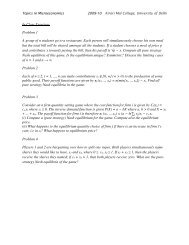


![2. Each of n ≥ 2, i = 1, ..., n can make contributions s i ∈ [0, w] (w ...](https://img.yumpu.com/19311695/1/190x245/2-each-of-n-2-i-1-n-can-make-contributions-s-i-0-w-w-.jpg?quality=85)
